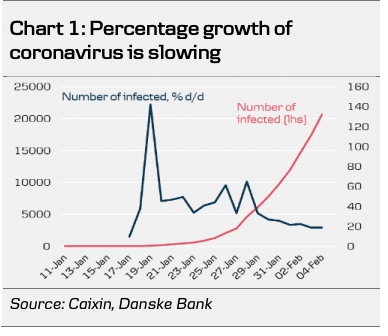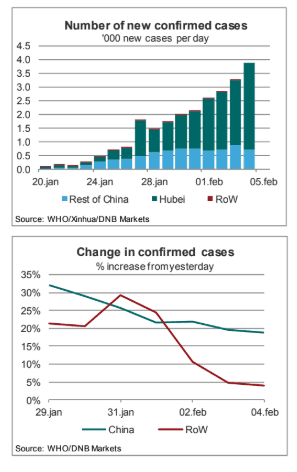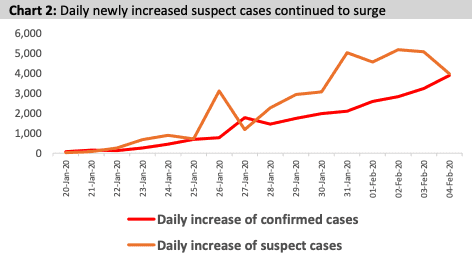Why Markets are Losing their Fear of Coronavirus
- WHO says "no therapeutic treatment" for virus.
- Only "intensive care" helps severe virus cases.
- Virus growth rate slows and suspected cases fall.
- AUD and ZAR on front foot as safe-havens slide.
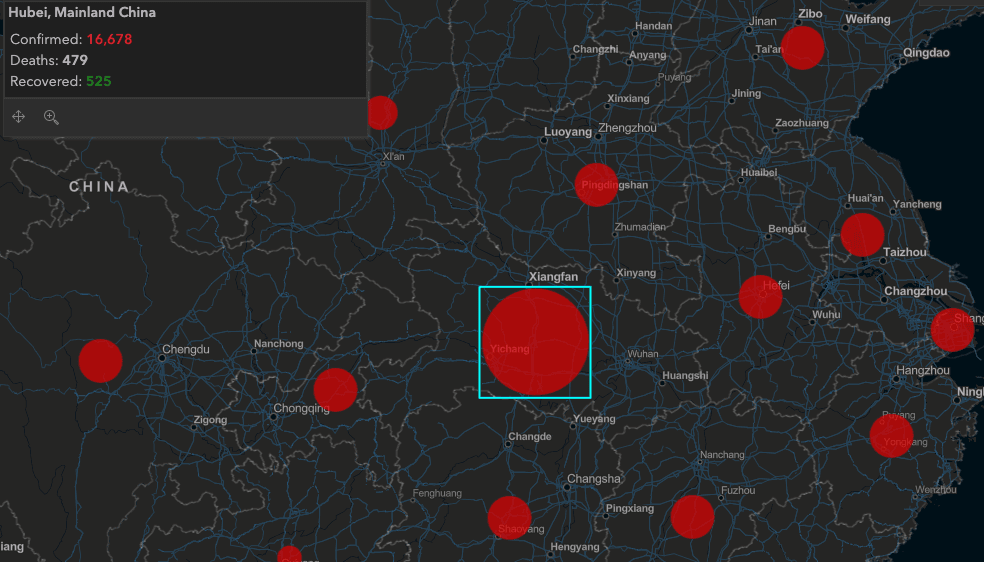
Image © Johns Hopkins CSSE
The coronavirus outbreak in China remains the single most important driver of global investor sentiment with markets rising this week as investors bet the virus outbreak has reached an inflection point. Markets were a sea of red last week as the virus outbreak exploded, but the polar opposite is true this week amidst evidence that the spread of the disease is waning.
Safe-haven currencies such as the Japanese Yen and Swiss Franc have turned lower as investors instead opt to invest in higher-yielding assets, such as stocks. Currencies with a sizeable exposure to the Chinese market - such as the Australian Dollar and Rand have meanwhile turned higher.
"Wall Street has endured the great selloff of January 2020 and now seems poised to resume its march higher, having apparently consigned the Coronavirus to the ever-growing dustbin of things that seemed like a major problem at the time, but in the end, weren’t," says Chris Beauchamp, Chief Market Analyst at IG. "The rally has been broad-based, too, encompassing sectors and countries in a manner that suggests investors have mostly overcome their fears about a global outbreak."
As of February 06, the total number of confirmed cases stood at 28292 according to Johns Hopkins CSSE, up from 27.4K the previous day, with the number of deaths rising to 656 and the number of recoveries now well above the 1000 mark at 1219.
We expect stock markets to continue moving higher and safe-haven currencies such as the Franc to turn lower unless some key numbers concerning the virus start to turn for the worse.
For markets, the key number appears to be related to the rate the infection spreads, because this gives insight into how long the crisis can persist.
The below graph from Danske Bank confirms the rate of spread of the coronavirus is slowing, even if the total number of confirmed cases continues to grow.
"After a couple of weeks dominated by fears of the Coronavirus, and a quiet day key figure-wise, equity indices rose on a broad basis for the second day in a row yesterday. Markets showed signs of increased risk appetite, as equities and bond yields rose on a broad basis. Bond yields were up over 4 bps in several countries. The USD weakened against JPY and CNY. The NOK strengthened again, after reaching record weak levels the past days, another sign that risk appetite is back," says Oddmund Berg, an analyst at DNB Markets.
But there are other key statistics and trends the markets are eyeing.
"I know the headline looks bleak but here is the light at the end of the tunnel. It is the first time that the number of suspect cases flatlined yesterday," says Tommy Xie, Head of Greater China Research at OCBC Bank.
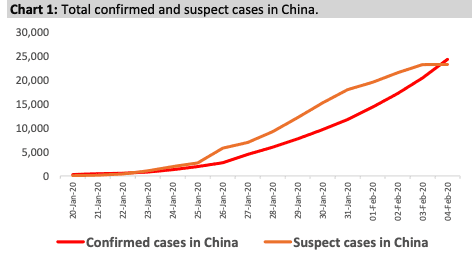
"In Hubei province, we have seen an encouraging divergence with the daily confirmed cases exceeded daily suspect cases for the first time," says Xie. "It seems that Hubei has tried their best to identify all the infected patients. The efforts may help lower the reproductive rate of infection and R0 is expected to slow down. Outside Hubei province, we have not seen evidence of second wave contagion. Daily increase of newly confirmed cases stabilized again after a small surge."
With the charts heading in the right direction, we would expect the current market reaction to extend further.
Above image courtesy of OCBC
No Quick Cure
Markets were on Wednesday cheered by reports that a research team at Zhejiang University had found an effective drug to treat people with the coronavirus.
The World Health Organization (WHO) later released a statement that tempered optimism, saying there was no effective cure, a view later shared by Chinese officials.
LIVE: Press briefing on the #2019nCoV outbreak with @DrTedros https://t.co/VYKBDINtRJ
— World Health Organization (WHO) (@WHO) February 5, 2020
The mood on global markets is the polar opposite of that seen exactly one week ago when fears of a global slowdown were elevated as a result of the virus, but a WHO spokesperson said mid-morning that there's still "no known effective therapeutics against the virus. There are no proven effective therapeutics for the novel coronavirus...a high standard of care is important...is predominantly causing disease and death among older patients...many patients at the severe end will survive if given adequate intensive care."
A 15:00 press conference saw representatives of the international body confirm there's still no treatment for it, while neglecting to give straight answers to media questions about the veracity of China's disclosures around the matter.
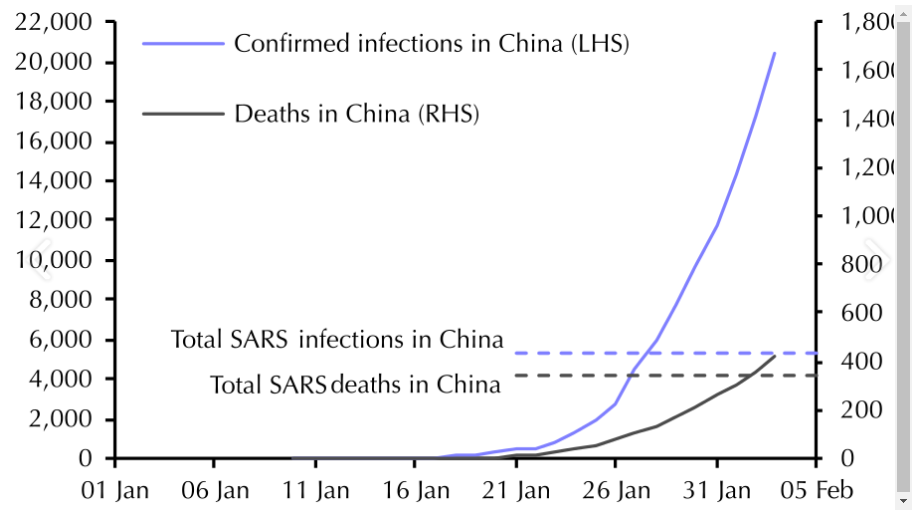
Above: Capital Economics graph contrasting coronavirus infection and death numbers with those of SARS.
The number of confirmed cases continues to grow alongside the death toll, which might ultimately put a cap on the market's bullish sentiment.
"The Wuhan virus – and the extensive efforts to contain it – will deliver a substantial hit to growth in China over the coming months and poses a more significant threat to the global economy and world markets than has been the case with previous epidemics. But beyond this, we're left facing more questions than answers," says Neil Shearing, chief economist at Capital Economics.
China's National Health Commission said overnight that as of midnight on Tuesday, it was aware of 24,324 confirmed cases, up from 20,438 the previous day, while the number of fatalities rose from 425 to 490. But those numbers don't capture the increase in confirmed cases outside of China. According to Johns Hopkins University's CSSE, the total confirmed cases stands at 24551 on Wednesday, with deaths at 493 and the total recovered at 910.
However, Taiwanese daily Taiwan News reported Wednesday that the true number of infections in China could be as high as 154,023 and the number of deaths as high as 24,589. It cited information that was momentarily displayed on a Tencent information board which, if correct, would imply a mortality rate of more than 15%. That's somewhat different to the low-single-digit mortality rate purported by official numbers.
Wednesday is reportedly the third time that Tencent numbers have been drastically higher than the official statistics of the National Health Commission. Official numbers have implied remarkably uniform and stable growth rates for infections and the numbers of deaths, with last week's pattern showing numbers increasing by around 30% in each category on a daily basis only for the growth rates of each to then decline to around 15% thus far this week.

